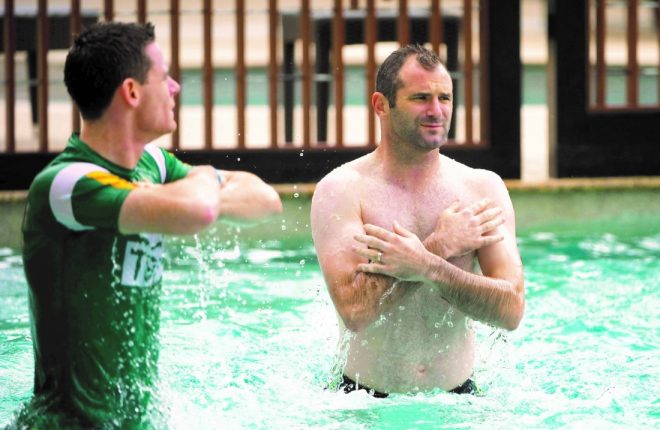
Ireland’s Steven McDonnell and captain Stephen Cluxton, left, during a ‘recovery session’ in the swimming pool in advance of the 2011 2nd International Rules Series 2011
AT the weekend Ballyholland GAC hosted a very successful awards evening in Newry Golf Club when over 200 club members congregated at the venue in anticipation of an excellent evening and they weren’t to be disappointed.
The club had sourced two fantastic guests as speakers on the night, one was fellow Gaelic Life columnist Joe Brolly and the other was 2010 Down All-Star and former Collingwood player Martin Clarke.
Joe spoke fantastically well, covering a wide range of GAA and non-GAA related issues from humour, history and from the heart when he concluded by mentioning the fantastic work of his Opt for Life campaign.
Martin also spoke fantastically well and one of the pieces of advice for the young people in his speech is the inspiration for my article this week.
He mentioned about training and the fact it’s not who can train the longest or the hardest but who can recover the best.
I have been preaching for years that it’s not how hard you train but how well you recover.
The actual concept of recovery is a much neglected one I feel particularly in our own sport of GAA. Good, effective, efficient recovery cannot be over emphasised enough, it is absolutely pivotal in the progression and development of any player.
I don’t think coaches are educated enough in the wide variety of recovery methods available, ranging from an effective and sufficient structured cool down right through to bouts of recovery breaks during the in-season.
The cool down
Sometimes the cool down is treated as a quick skip into the changing rooms which doesn’t last for more than a couple of minutes but believe it or not, a really good cool down can be extremely beneficial if completed correctly. It should last approximately 10 minutes and should take the form of some light jogging to allow the CV system to return to normal followed by some static stretching which will help reduce the risk of injury in the next session.
Cold water
A simple cold shower is much more effective than a warm shower in the recovery process as it has been proven to actually improve the strength around the joints and limbs. There is a phenomenon surrounding the use of these very high tech recovery tanks and hydro pools, but studies and evidence have shown simply pure and simple cold water in a bath for a few minutes is just as effective at lowering the body temperature back to a normal level.
Hydration
A critical component in the whole recovery process, players really do tend to neglect this post training and particularly post matches with the temptation after the game to consume some alcohol before properly hydrating. Most players will hydrate properly in the lead up to games or training but it is after the sessions a player should drink 1.5litres for every 1k of body weight lost during the exercise or activity bout. Alternative to water is the possibility of a lightly diluted sports drink mixed with water. Ideally players should be weight before and after training and games and not allowed to leave the changing rooms if their weight has fallen below their starting weight which will come as a result of fluid loss.
Swimming pool session
A day or two after a tough session or game, players could frequent the use of a swimming pool, this would take the form of some light exercise including some low intensity swimming and some active in pool stretching. The swim pool will be a massive benefit in restoring mobility into the limbs and helping tired and fatigued muscles to fully recover from the high demands that have been placed upon them.
In-season down weeks
We have got to remember the players we are normally dealing with are not professional athletes; most players will get up the following morning from a game or training and have to put in a day’s work so the chances of fatigue setting in throughout the season are probably quite high. To help with this, it is recommended that after every five weeks of training and playing that the training load (by that I mean, the volume and intensity of the sessions) is significantly reduced for those specific players. Even a reduction in training from 60 minutes to 40 or 30 could help and provide players with a much-needed freshness and renewed vigour.
All of the above are different types of recovery strategies, that can all be applied simply at club level at no cost, obviously you have more expensive methods such as sports massage, hydro pools, sports garments, all that are still very effective methods but not cost effective.
There are obviously short-term recovery strategies and long term to help keep the players fresh and free from injury, but always lean towards the side of caution and remember in training sometimes less is always more.
comment@gaeliclife.com
Receive quality journalism wherever you are, on any device. Keep up to date from the comfort of your own home with a digital subscription.
Any time | Any place | Anywhere











